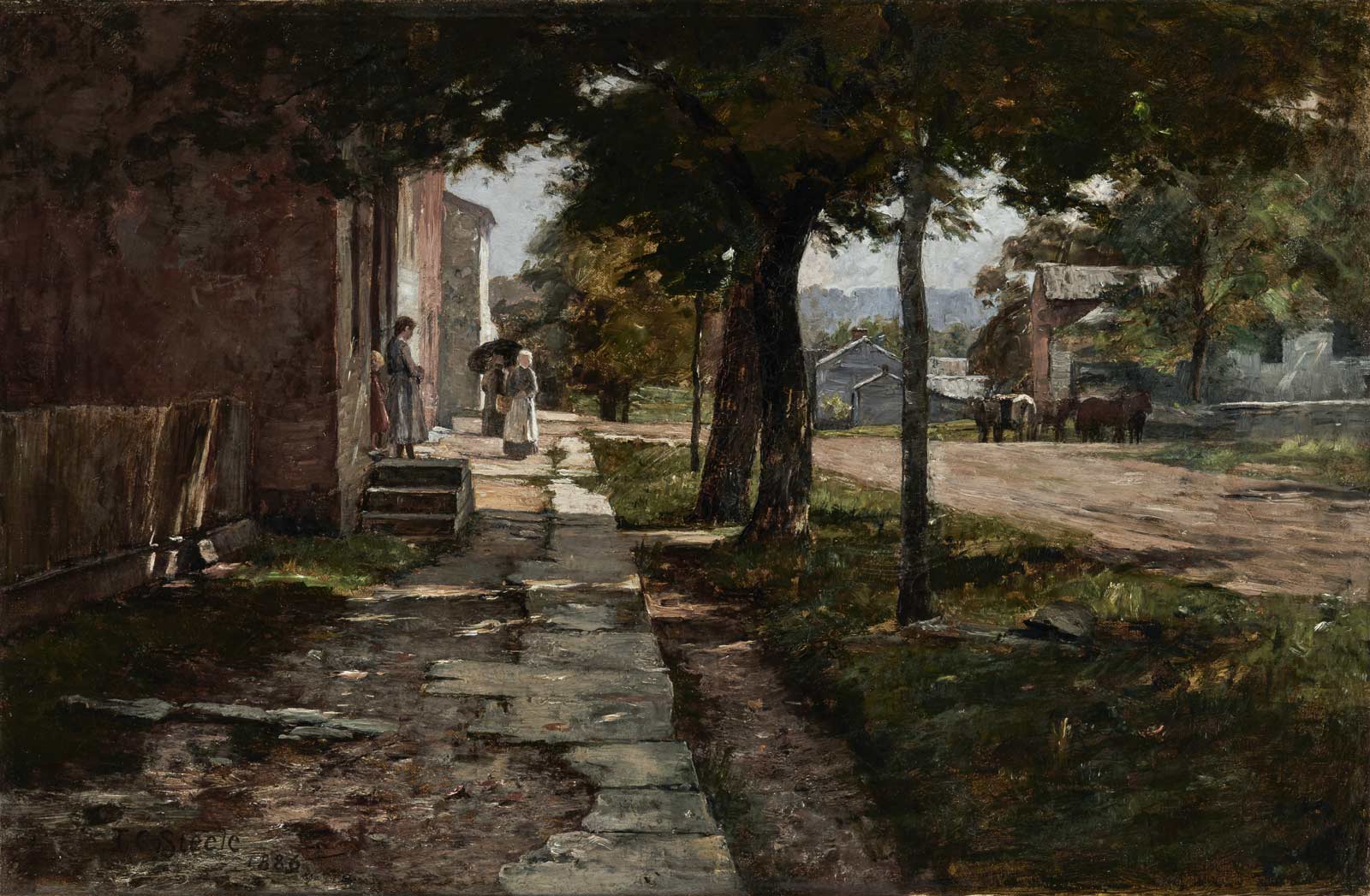
Theodore Clement Steele, American, 1847–1926
1886
Oil on canvas
45.72 cm x 71.12 cm | 18 in x 28 in
Signed and dated lower left
With permission, Indianapolis Museum of Art, gift of Jack and Marjorie Lee Farr Family
Accession Number: 2016.2
This painting depicts a view of Montgomery Street in the charming southern Indiana town of Vernon. Vernon is bordered on three sides by the winding waters of the Muscatatuck River.
Steele ability to capture the different effect of shade, dappled light, and bright sunshine are demonstrated in this painting. “Comments from the Artist’s journal also reveal his efforts to place the figures harmoniously within the scene.”1
T.C. Steele wrote in 1895:
“I wonder if the crimson oaks will ever look so fine, burn with such inward fire, and toned with such and envelope of ashen grey as those we used to see at Vernon”².
“This canvas was one of the first landscapes T.C. Steele painted upon his return to Indiana in 1885, following five years of study in Munich. The 1880’s landscapes are often considered the high point of a productive career that would continue for another 40 years.”1
“The donor’s family legend indicates that the scene was purchased directly out of Steele’s studio by a man who recognized the gray building of his father’s cabinet shop in the distant right of the composition.”1
Founded in 1815, Vernon was a planned community. US Surveyor Col. John Vawter, developed a detailed town plat and set aside spaces for schools, churches and recreation. Also, funds from each lot sold was used to finance the country library. Vernon gets its name after the home of George Washington, named by the town founder Col. Vawter.
Vernon claims several “firsts”:
- First elevated railroad and underpass west of the Alleghenies and still in use today – know by locals as “the culvert”.
- First Indiana town to have a public playground – this green field on the Muscatuck’s banks is called the “commons” and still in use today.
- First all-woman jury trial, held on June 6th, 1921 – just after ratification of the 19th amendment
- First woman’s Club, in the State of Indiana, the “Clonian Society” established in 1859.
Vernon also played an important part of the Underground Railroad and row houses where slaves were sheltered by citizens are located on State Highway 7 in Vernon, and is part of a tour volunteers give throughout the year.2
The entire town of Vernon, Indiana was listed on the National Register of Historic Places, August 27, 1976, Ref. #76000024 as “Vernon Historic District””.3
More recently;3
- “North Vernon Downtown Historic District”, listed May 19, 2006, Ref. #6000306
- “Walnut Street Historic District”, listed September 20, 2006, Ref. #6000855
- “State Street Historic District”, listed January 25, 2007, Ref. #6001290
Vernon also has three Indiana Historical Bureau Markers4

Jonathan Jennings 1784 – 1834 ID#: 40.1995.1 
Morgan’s Raid, July 1863 ID #: 72.2002.7 
Vernon Historic District ID#: 40.2003.1
1“Street in Vernon.” Indianapolis Museum of Art Online Collection. Accessed July 28, 2020. http://collection.imamuseum.org/artwork/84150/.
2Town of Vernon, Indiana. Accessed July 28, 2020. http://www.vernonindiana.org/.
3“National Register of Historic Places (U.S. National Park Service).” National Parks Service. U.S. Department of the Interior. Accessed July 28, 2020. https://www.nps.gov/subjects/nationalregister/index.htm.
4IHB: Indiana Historical Bureau – Located Downtown Indianapolis in the Indiana State Library: IHB. Accessed July 28, 2020. https://www.in.gov/history/.
